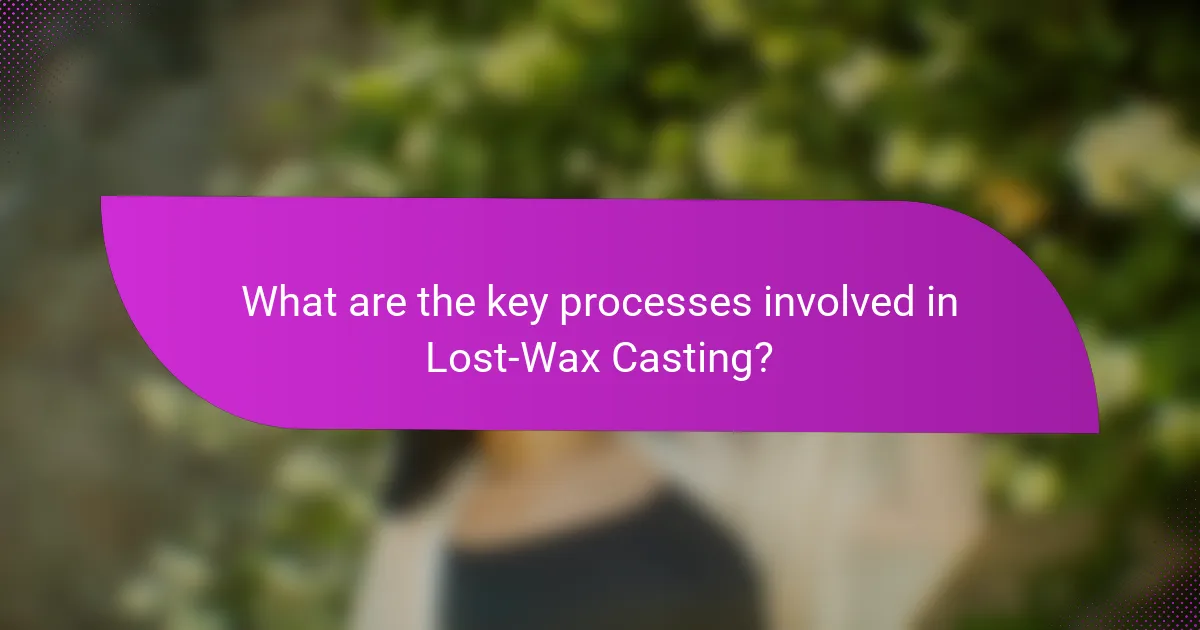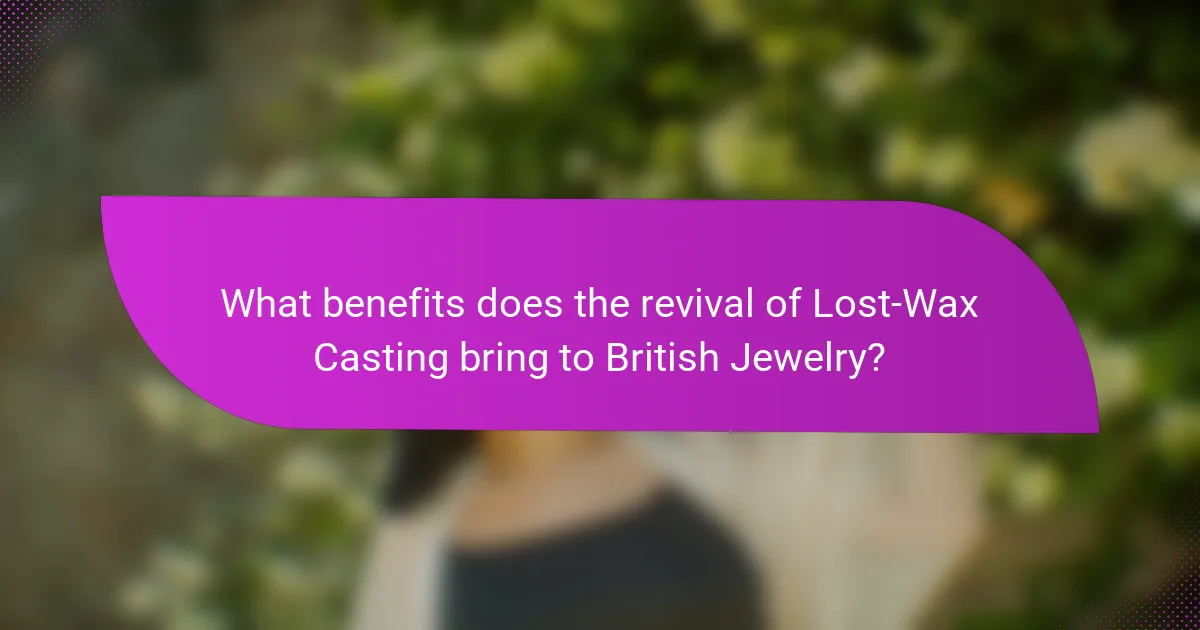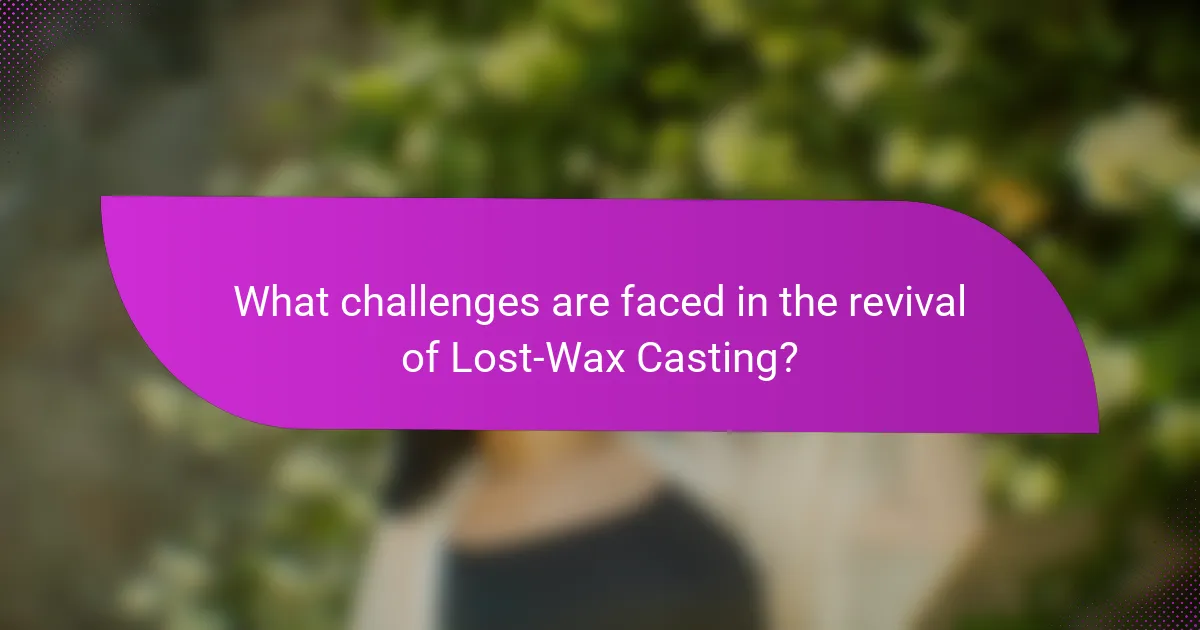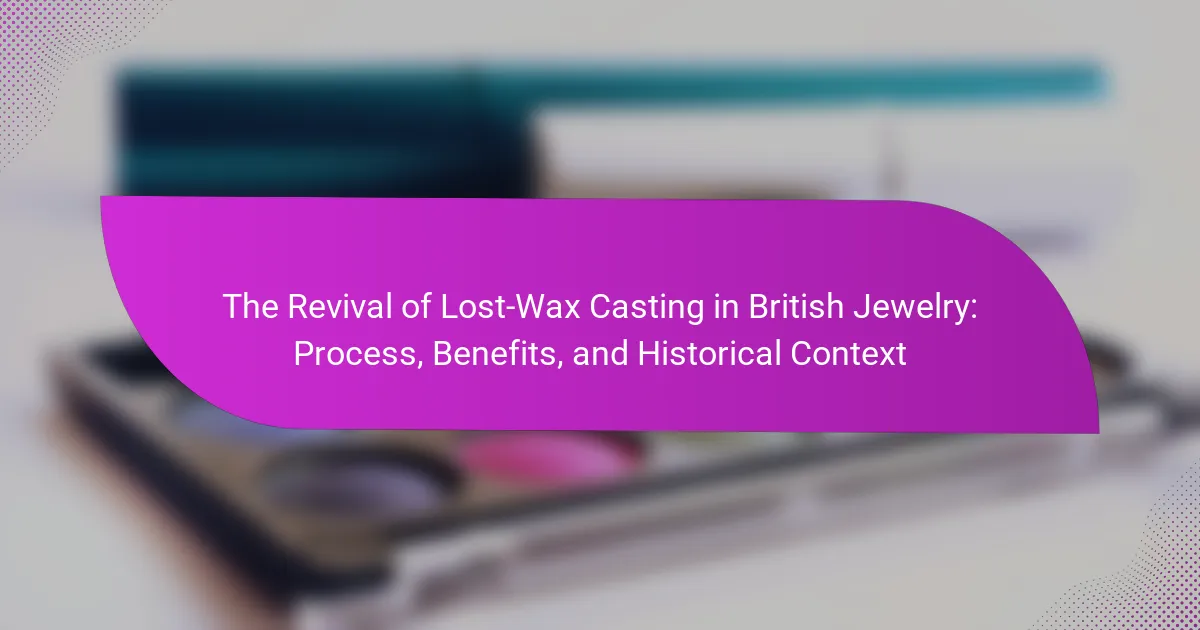Lost-wax casting is a traditional metal casting process utilized in British jewelry making, characterized by the creation of a wax model that is coated to form a mold. This method, which allows for intricate designs and fine details, has historical roots dating back thousands of years and continues to thrive among contemporary artisans. The article explores the key processes involved in lost-wax casting, including model creation, mold making, wax removal, casting, and finishing. It highlights the benefits of this revival, such as enhanced craftsmanship, sustainability through recycled materials, and support for local artisans. Additionally, the article addresses challenges faced in the revival of lost-wax casting, including high material costs, a skills gap among artisans, and market competition from faster, cheaper contemporary jewelry methods.

What is Lost-Wax Casting in British Jewelry?
Lost-wax casting is a metal casting process used in British jewelry making. It involves creating a wax model of the desired piece. The model is then coated with a heat-resistant material to form a mold. Once the mold is set, the wax is melted away, leaving a cavity. Molten metal is poured into this cavity to create the final piece. This technique allows for intricate designs and fine details. Historically, it dates back thousands of years and is still popular today among artisans. The precision and quality of lost-wax casting make it a favored method in contemporary British jewelry.
How has Lost-Wax Casting evolved over time?
Lost-wax casting has evolved significantly from its ancient origins to modern applications. Initially used in ancient civilizations, such as Mesopotamia and Egypt, it allowed artisans to create intricate metal objects. The process involves creating a wax model, which is then encased in a mold. Once heated, the wax melts away, leaving a cavity for molten metal.
In the Middle Ages, lost-wax casting became a key technique for creating religious artifacts and jewelry in Europe. The Renaissance period saw a resurgence in its popularity, driven by advancements in metallurgy and artistry.
Modern technology has introduced new materials and methods, enhancing precision and efficiency. Today, lost-wax casting is widely used in various industries, including jewelry, art, and aerospace. The method remains valued for its ability to produce detailed and complex designs.
What historical significance does Lost-Wax Casting hold in British Jewelry?
Lost-wax casting has significant historical importance in British jewelry. This technique dates back thousands of years and has been used in various cultures. In Britain, it gained prominence during the medieval period. Artisans employed lost-wax casting to create intricate designs and detailed metalwork. It allowed for greater creativity and precision compared to other methods. The technique contributed to the development of distinctive British jewelry styles. Notable examples from this era include religious artifacts and ornate personal adornments. The revival of this method in modern times highlights its enduring legacy in British craftsmanship.
What are the key milestones in the revival of this technique?
The key milestones in the revival of lost-wax casting in British jewelry include the rediscovery of ancient techniques in the late 20th century. This rediscovery was driven by artisans seeking traditional craftsmanship methods. In the 1980s, workshops began to emerge that specialized in lost-wax casting, allowing jewelers to experiment with the process. By the 1990s, the technique gained popularity among contemporary jewelry designers. The establishment of educational programs focused on metalworking further supported its revival. In 2000, exhibitions showcasing lost-wax cast pieces highlighted its artistic potential. Today, the technique is celebrated for its intricate detail and artistic expression in British jewelry design.
Why is Lost-Wax Casting important for contemporary jewelers?
Lost-wax casting is important for contemporary jewelers because it allows for intricate designs and detailed craftsmanship. This method enables jewelers to create unique pieces that are difficult to achieve with other techniques. The process involves creating a wax model, which is then encased in a mold. Once the mold is heated, the wax melts away, leaving a cavity for molten metal. This technique has been used for thousands of years, proving its reliability and effectiveness. Additionally, lost-wax casting supports small-scale production, allowing artisans to maintain creative control. Many contemporary jewelers appreciate its historical significance and the connection it provides to traditional craftsmanship.
What advantages does Lost-Wax Casting offer compared to other methods?
Lost-wax casting offers several advantages over other methods. It allows for intricate designs and fine details that are difficult to achieve with traditional casting methods. The process provides a high level of precision, which is essential in jewelry making. Additionally, lost-wax casting enables the creation of complex shapes without the need for extensive tooling. This method also reduces material waste, as the wax can be reused. Historical data indicates that lost-wax casting has been used for thousands of years, demonstrating its reliability and effectiveness. The ability to produce unique, one-of-a-kind pieces is another significant benefit. Overall, lost-wax casting combines artistry with efficiency, making it a preferred method in the jewelry industry.
How does this technique enhance artistic expression in jewelry design?
Lost-wax casting enhances artistic expression in jewelry design by allowing for intricate detail and unique forms. This technique enables artisans to create complex shapes that are difficult to achieve with traditional methods. The process involves crafting a wax model, which captures fine details and textures. Once the model is covered in a mold, the wax is melted away, leaving a precise cavity. This results in a metal casting that retains the original model’s intricacies. Historical evidence shows that lost-wax casting has been used since ancient civilizations, demonstrating its long-standing significance in artistic expression. The ability to replicate fine details allows jewelers to push creative boundaries and produce one-of-a-kind pieces.

What are the key processes involved in Lost-Wax Casting?
The key processes involved in Lost-Wax Casting include model creation, mold making, wax removal, casting, and finishing. First, artisans create a model from a material like wax. This model is then coated with a heat-resistant material to form a mold. Once the mold is set, the wax is melted and drained away, leaving a cavity. Molten metal is poured into this cavity to form the final object. After cooling, the mold is broken to reveal the cast piece. Finally, artisans clean and finish the piece to achieve the desired appearance. Each step is crucial for achieving precision and detail in the final product.
How is the Lost-Wax Casting process executed step by step?
The Lost-Wax Casting process is executed in several key steps. First, an original model is created from wax. This model is an exact replica of the desired final product. Next, a mold is made around the wax model using a heat-resistant material. Once the mold is set, the wax model is melted and drained away, leaving a hollow cavity. Afterward, molten metal is poured into this cavity to form the final shape. Once the metal cools and solidifies, the mold is broken away to reveal the cast object. Finally, any excess metal is trimmed, and the piece is polished for finishing. Each step is crucial for achieving high-quality results in jewelry making.
What materials are required for the Lost-Wax Casting process?
The materials required for the Lost-Wax Casting process include wax, a mold material, and metal. Wax is used to create the initial model of the object. The mold material, often made from a ceramic shell or plaster, encases the wax model. Once the mold is formed, the wax is melted away, leaving a cavity. Finally, molten metal is poured into the cavity to create the final object. This process has been used for centuries in various cultures, confirming its effectiveness in metalworking.
How do artisans prepare the wax model for casting?
Artisans prepare the wax model for casting by meticulously sculpting the desired shape from wax. They use various tools to achieve precision in details. After sculpting, artisans often heat the wax to smooth the surface. This heating process ensures that any imperfections are corrected. Once the model is perfected, it is coated with a thin layer of investment material. This investment material hardens around the wax. The hardened mold is then heated to melt and remove the wax. This process creates a cavity for the molten metal during casting. The method is essential for achieving intricate designs in jewelry.
What role does technology play in modern Lost-Wax Casting?
Technology enhances modern Lost-Wax Casting by improving precision and efficiency. Computer-aided design (CAD) software allows artisans to create detailed models. 3D printing technology facilitates rapid prototyping of wax patterns. This reduces time and material waste in the casting process. Advanced temperature control systems ensure consistent melting and pouring of metals. Additionally, digital scanning technology aids in replicating intricate designs. These technological advancements lead to higher quality and more intricate jewelry pieces. The integration of technology has revitalized traditional methods, making them more accessible to contemporary artisans.
How have advancements in technology improved the casting process?
Advancements in technology have significantly improved the casting process by enhancing precision and efficiency. Modern methods such as 3D printing allow for intricate designs that were previously unattainable. These technologies enable rapid prototyping, reducing the time from design to production. Additionally, computer-aided design (CAD) software facilitates detailed modeling and adjustments before casting. Improved materials, like high-performance alloys, increase the durability of cast items. Automated systems have streamlined workflows, minimizing manual errors. Collectively, these advancements lead to higher quality and consistency in cast products, benefiting the jewelry industry.
What tools are essential for contemporary jewelers using this method?
Essential tools for contemporary jewelers using lost-wax casting include a wax injector, a casting flask, and a furnace. The wax injector allows jewelers to create precise wax models. The casting flask holds the investment material that encases the wax model. A furnace is necessary to melt the metal for casting. Additional tools include a vacuum chamber for removing air bubbles and a torch for soldering. These tools are critical for achieving high-quality results in the lost-wax casting process.

What benefits does the revival of Lost-Wax Casting bring to British Jewelry?
The revival of Lost-Wax Casting brings several benefits to British Jewelry. It enhances craftsmanship by allowing intricate designs that are difficult to achieve with other methods. Artisans can create unique pieces with fine details. This method also promotes sustainability through the use of recycled materials. The revival supports local artisans, boosting the economy and preserving traditional skills. It fosters a connection to historical practices, enriching the cultural heritage of British Jewelry. Additionally, Lost-Wax Casting allows for greater customization, meeting individual customer demands effectively. This technique has been used for centuries, proving its reliability and artistic value in jewelry making.
How does Lost-Wax Casting contribute to sustainability in jewelry making?
Lost-wax casting contributes to sustainability in jewelry making by minimizing material waste. The process allows jewelers to create intricate designs with precise control over the amount of metal used. This method recycles metal effectively, as leftover material from the casting process can be reused in future projects. Additionally, lost-wax casting often utilizes ethically sourced metals, reducing the environmental impact associated with mining. Studies show that using recycled materials can significantly lower energy consumption and carbon emissions in jewelry production. By adopting lost-wax casting, jewelers can produce high-quality pieces while promoting sustainable practices.
What environmental advantages does this method offer?
Lost-wax casting offers several environmental advantages. This method minimizes waste by using only the necessary amount of metal. It allows for the recycling of materials, reducing the need for new raw resources. Additionally, lost-wax casting typically requires less energy compared to other metalworking techniques. The process often generates fewer emissions due to its efficiency. Furthermore, it supports sustainable practices by enabling artisans to use eco-friendly materials. Studies show that traditional casting methods can lead to significant waste, while lost-wax casting effectively addresses this issue.
How does the revival support local artisans and craftsmanship?
The revival of lost-wax casting supports local artisans and craftsmanship by providing them with renewed opportunities for traditional skills. This revival creates demand for handmade jewelry, allowing artisans to showcase their work. Increased interest in unique, handcrafted pieces encourages consumers to value local artistry. Local artisans benefit from workshops and training programs that enhance their skills. The revival also fosters community networks among artisans, promoting collaboration and sharing of techniques. Economic support for artisans leads to sustainable practices in craftsmanship. Historical appreciation of lost-wax casting enriches local culture and heritage. Overall, the revival strengthens the local economy by empowering artisans and preserving traditional craftsmanship.
What are the aesthetic benefits of using Lost-Wax Casting?
Lost-wax casting offers significant aesthetic benefits in jewelry making. This method allows for intricate designs and fine details that are difficult to achieve with other techniques. The process captures textures and patterns accurately, enhancing the visual appeal of the piece. Additionally, it enables the creation of unique shapes that can be customized for individual preferences. The final products often exhibit a smooth finish, contributing to their overall elegance. Historical use of lost-wax casting dates back thousands of years, demonstrating its enduring aesthetic value in art and jewelry.
How does this technique influence the uniqueness of jewelry pieces?
Lost-wax casting significantly influences the uniqueness of jewelry pieces. This technique allows for intricate designs that are difficult to replicate. Each piece is crafted from a unique model, ensuring no two items are exactly alike. The process involves creating a wax model, which is then encased in a mold. Once the mold is heated, the wax melts away, leaving a cavity for molten metal. This method captures fine details and textures, enhancing the individuality of each piece. Historical use of lost-wax casting dates back thousands of years, underscoring its effectiveness in producing unique artifacts. The artistry involved further elevates the distinctiveness of jewelry created through this technique.
What are the visual characteristics that set Lost-Wax Cast jewelry apart?
Lost-Wax Cast jewelry is distinguished by its intricate details and unique textures. The casting process allows for fine features that are often unattainable with other methods. Each piece showcases a high level of craftsmanship, evident in the precision of the designs. The surface finishes can vary from polished to matte, enhancing visual appeal. Additionally, Lost-Wax Cast jewelry often displays organic shapes and flowing lines, reflecting the artist’s vision. This technique can also capture minute details, such as engravings and patterns, which add depth to the piece. The final result is a highly individualistic item, often with a tactile quality that invites closer inspection. These characteristics collectively highlight the uniqueness of Lost-Wax Cast jewelry in the market.

What challenges are faced in the revival of Lost-Wax Casting?
The revival of Lost-Wax Casting faces several challenges. One significant challenge is the high cost of materials. Precious metals and wax can be expensive, impacting production budgets. Additionally, there is a lack of skilled artisans. Many traditional techniques have been lost over time, leading to a skills gap.
Another challenge is the need for advanced technology. Modern equipment can improve precision but requires significant investment. There are also issues with sustainability. The environmental impact of sourcing materials and waste management is a growing concern.
Market competition poses a challenge as well. Contemporary jewelry methods are often faster and cheaper. Finally, consumer awareness is limited. Many potential buyers are unfamiliar with the craft and its benefits. These factors collectively hinder the revival of Lost-Wax Casting in British jewelry.
What obstacles do modern jewelers encounter when using this technique?
Modern jewelers encounter several obstacles when using the lost-wax casting technique. The process requires high precision, which can be challenging to achieve consistently. Jewelers often face difficulties in creating detailed wax models that capture intricate designs. Additionally, the casting process can result in defects, such as air bubbles or incomplete fills. These defects necessitate time-consuming repairs or remakes, increasing production time and costs. The need for specialized equipment, such as furnaces and molds, can also be a barrier for smaller jewelers. Furthermore, sourcing high-quality materials for both the wax and final metal can be problematic. Lastly, the technique demands significant skill and experience, which may not be readily available among all modern jewelers.
How do cost factors impact the feasibility of Lost-Wax Casting?
Cost factors significantly impact the feasibility of Lost-Wax Casting. The process requires materials such as wax, metal, and investment compounds, which can be expensive. High-quality metals, like gold and silver, increase overall costs. Labor costs also affect feasibility, as skilled artisans are needed for precise work. Additionally, the complexity of designs can lead to higher production costs. If costs exceed budget constraints, it may limit the use of this technique in jewelry making. Historical data shows that fluctuations in metal prices directly influence production decisions in the jewelry industry. Thus, understanding cost factors is crucial for assessing the viability of Lost-Wax Casting in contemporary practices.
What skills are necessary for artisans to master this process?
Artisans must master several skills to effectively execute the lost-wax casting process. These skills include sculpting, which allows artisans to create detailed wax models. Precision is critical in this craft, ensuring that every detail is captured accurately in the wax. Knowledge of materials is essential, particularly understanding the properties of wax and metal.
Artisans also need to be proficient in temperature control, as the melting and pouring of metals require specific heat levels. Additionally, they must possess problem-solving skills to address challenges that arise during the casting process. Attention to detail is paramount, as even minor imperfections can affect the final product. Lastly, artisans should have a strong understanding of finishing techniques to enhance the quality of the final jewelry piece.
How can jewelers overcome challenges in Lost-Wax Casting?
Jewelers can overcome challenges in Lost-Wax Casting by refining their techniques and using high-quality materials. Improved wax models can reduce imperfections in the final cast. Utilizing better investment materials enhances mold strength and detail retention. Proper temperature control during the melting and pouring process minimizes defects. Regular maintenance of equipment ensures consistent performance and quality. Training and education on advanced casting methods can further enhance skill levels. Adopting modern technologies, such as 3D printing for wax models, can streamline the process. Each of these strategies addresses specific challenges faced in Lost-Wax Casting, leading to improved outcomes in jewelry production.
What best practices can enhance the success of Lost-Wax Casting?
To enhance the success of Lost-Wax Casting, meticulous attention to detail is essential. First, ensure that the wax model is precise and free of imperfections. This precision affects the final product’s quality. Next, choose the appropriate type of wax for the model. Different waxes have varying melting points and properties.
Additionally, proper venting is crucial during the casting process. Venting allows gases to escape, preventing defects in the final piece. Maintaining the correct temperature during the melting and pouring stages is also vital. Overheating can lead to material degradation.
Using high-quality investment material is another best practice. Investment materials should withstand high temperatures and provide a smooth finish. Lastly, allow adequate time for cooling and solidification. Rushing this process can result in fractures or incomplete casts. Following these best practices can significantly improve the outcomes in Lost-Wax Casting.
What resources are available for learning and improving this technique?
Books on lost-wax casting techniques are available for learners. “The Complete Guide to Lost-Wax Casting” by John M. W. Wright provides comprehensive insights. Online courses on platforms like Skillshare and Udemy offer practical lessons. YouTube channels dedicated to jewelry making also feature tutorials on lost-wax casting. Local workshops and community colleges often host classes on metalworking techniques. Museums with jewelry exhibitions may provide resources and demonstrations. Professional organizations like the Jewelry Arts Institute offer workshops and networking opportunities. These resources enhance skills and knowledge in lost-wax casting.
What practical tips can jewelers apply for successful Lost-Wax Casting?
Jewelers can enhance their Lost-Wax Casting results by following specific practical tips. First, ensure the wax model is meticulously crafted to capture fine details. Smooth surfaces prevent imperfections in the final cast. Second, invest in high-quality investment material for better mold integrity. This enhances the accuracy of the final piece. Third, control the temperature during the burnout process. A gradual increase prevents cracking and ensures complete wax removal. Fourth, maintain a consistent pouring temperature for the metal. This helps achieve a smooth flow into the mold. Fifth, use adequate venting in the mold to allow gases to escape. This reduces the risk of defects. Lastly, practice proper safety protocols when handling materials. Safety ensures a secure working environment. Following these tips can significantly improve the success rate of Lost-Wax Casting in jewelry making.
The main entity of the article is lost-wax casting, a metal casting technique used in British jewelry making. The article explores the historical significance, evolution, and contemporary relevance of lost-wax casting, highlighting its intricate processes and advantages over other methods. Key topics include the steps involved in the casting process, the role of technology, and the environmental and economic benefits of its revival. Additionally, the article addresses the challenges faced by modern jewelers and provides practical tips for successful implementation of this traditional technique. Overall, it emphasizes the enduring legacy and artistic potential of lost-wax casting in British jewelry design.
